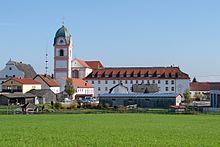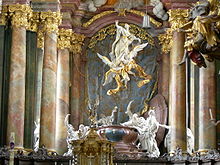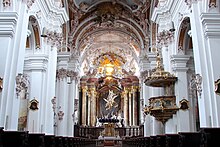Rohr Monastery (Lower Bavaria)
The monastery Rohr is a former monastery of the Augustinian Canons and today a Benedictine abbey in Rohr in Lower Bavaria in the diocese of Regensburg , which belongs to the Bavarian Benedictine Congregation . The official name is: Abbey of St. Wenzel zu Braunau in Rohr .
history
The Augustinian Canons' Monastery (1133–1803)
In 1133 the noble Adalbert von Rohr, to whom his wife had died the year before after a childless marriage, gave his property to the Regensburg bishop on the condition that an Augustinian canon monastery be established in Rohr, which he himself wanted to join. On October 10, 1133, Bishop Heinrich I appointed Bruno as the first provost of the new foundation; where he and the first canons came from is not known. In 1136 Pope Innocent II took the monastery into apostolic protection and confirmed the Augustinian rule, as did Pope Eugene III. in 1153. In 1158, at the request of the provost, Emperor Friedrich Barbarossa took the monastery under imperial protection and confirmed ownership of the monastery. From 1138 the Abensbergers held the monastery bailiwick until it passed to the Wittelsbachers when it died out in 1485 .
The pen did well in its first century. In the middle of the 13th century there was a crisis; On the one hand, the pen had to defend itself against the attacks of the Counts of Moosburg , on the other hand there were differences within the convent. Bishop Leo von Regensburg was forced to remove Provost Konrad II (1269–1270) for 16 months because he was in dispute with his convent. After that, the pen recovered.
At the beginning of the 15th century there was another crisis and a rapid decline, without the causes being finally apparent. The Bavarian duke and the Regensburg bishop then installed the Augustinian canon Petrus Fries from the reformed monastery in Indersdorf as provost in Rohr. He came with five canons and his reform work soon bore fruit; therefore he is also referred to as the “second founder” of the monastery. When Fries was appointed visitor of the Bavarian Augustinian canons by Nikolaus von Kues in 1452 , Rohr itself had become a center of the reform movement.
In the Landshut War of Succession , the Markt and Stift Rohr were badly damaged. During the Reformation, the convent melted down considerably, but adhered strictly to the rules of the order and to the old faith. During the Counter Reformation , the number of Rohr canons rose again. In 1595 Pope Clemens VIII awarded Provost Johann Holnsteiner (1589–1630) the pontificals . Since the monastery was economically sound, the church and monastery could now be structurally repaired. In 1632, however, a catastrophe occurred when the Swedish King Gustav Adolf Rohr destroyed in the Thirty Years War . The monastery went up in flames, only the church and some farm buildings were spared. The imperial troops who billeted themselves in Rohr in 1648 showed themselves no better than the Swedes; now the valuable library and part of the monastery archives were robbed by the fire they started. The church was also badly affected.
After the Peace of Westphalia in 1648, the monastery recovered. In 1682, under Provost Patritius Freiherr von Heydon, a successful new era began. During his 48-year reign (he died in 1730) the monastery buildings and the church were rebuilt in baroque splendor. Egid Quirin Asam created the high altar of the collegiate church, which depicts the Assumption of Mary in full plastic as “ Theatrum sacrum ”, from 1722 to 1723; perhaps he was not only the decorator but also the builder of the church.
The organ was built in 1725 by Johann Konrad Brandenstein . In 2006 she received a new organ from Metzler Orgelbau with 29 registers on two manuals and pedal .
In 1715 the monastery joined the Lateran Congregation . In 1760/61 the east wing of the monastery was completed as the last construction phase.
Not only externally, but also internally the pen was doing well. Canons were sent to study in Ingolstadt , Dillingen and Rome. Instrumental music was cultivated, a boys' club for singers and a secondary school were founded and there was a scientific activity.
The secularization , which was announced to the last provost Petrus Pustet on March 29, 1803 , ended a flourishing monastery life. The monastery buildings went into private ownership and were half demolished. The rectory and a school were housed in the east wing of the monastery, and a tavern was set up in part of the west wing. The collegiate church was allowed to survive as a parish church; But the chapel of the Holy Spirit, the burial place of the Abensbergers and the Rohrer provosts were destroyed.
Attempts at revival in the 19th century
In 1880 the Cistercian women from the Seligenthal Landshut monastery and in 1890 the Premonstratensians from the Wilten monastery tried to revive monastic life in Rohr; both attempts failed.
Revitalized as a Benedictine abbey in the 20th century
After the Second World War , the displaced Benedictine monks from the Bohemian Braunau monastery settled in the former monastery in 1946 . They dedicated their new monastery to St. Wenceslaus . From then on they carried out pastoral care in the surrounding area, built the Johannes Nepomuk grammar school with boarding school, which was in the old tradition of the Braunau collegiate grammar school, and renovated the old buildings step by step. In 1947, 29 fathers and brothers lived in the monastery, the number of which rose to 38 in 1973, but has continuously decreased since then. Closely associated with the Rohr monastery are the Catholic Sudeten Germans who came together as the Ackermann congregation after their expulsion from Czechoslovakia and who, together with their youth association Junge Aktion, organize many events in the monastery.
Head of the monastery since the resettlement
- Dominik Prokop (1929–1969, in Rohr from 1946), Dept.
- Virgil Kinzel (1970–1988), Dept.
- Johannes Zeschick (1988–2002), Dept.
- Gregor Zippel (2002-2010), Dept.
- Markus Eller (2010–2016), Dept. Administrator
- Barnabas Bögle (since 2016), Abbot administrator
All the abbots were expelled from their homes . Since 2010 there has been no more abbot in the monastery. In 2018, the long-sought reunification of the Břevnov (Breunau) and Broumov (Braunau) abbeys, in whose tradition the Rohr abbots were, became legally binding by a decree of the Vatican Congregation. The Archabbot of the Břevnov Monastery can now (again) bear the title "Archabbot of Břevnov and Broumov".
Monastery church
Klosterrohr municipality
Until 1875, the municipality, which was completely enclosed by the municipality of Rohr, was officially called Rohr, Kloster . Then it was renamed Klosterrohr . On January 1, 1910, it lost its independence and was incorporated into the Rohr municipality, now Rohr in Lower Bavaria.
literature
- Paul Mai: Rohr . In: The same: The «Windesheimer» Augustinian canons in the diocese of Regensburg - then and now. In: Contributions to the history of Eichstätt. Brun Appel on his 65th birthday. (= Collective sheet 92nd / 93rd year) Eichstätt 1999/2000, pp. 50-55.
- Johannes Zeschick, Simon Weiss: Benedictine abbey church in Rohr in Lower Bavaria. Kunstverlag Josef Fink, Lindenberg 2015, ISBN 978-3-89870-900-2 .
- Edmund Wagenhofer OSB: Reunification in the Czech Republic. The Brevnov and Broumov Abbeys, in: Erbe und Dienst , 94 (2018), p. 215.
Individual evidence
- ↑ Julius Bittmann in the Traunsteiner Tagblatt of March 28, 2018 Threatened by the dying of the monastery , accessed on November 22, 2018
- ^ Wilhelm Volkert (ed.): Handbook of Bavarian offices, communities and courts 1799–1980 . CH Beck, Munich 1983, ISBN 3-406-09669-7 , p. 493 .
Web links
-
Rohr monastery (Lower Bavaria) , basic data and history:
Stephanie Haberer: Rohr monastery - Augustinian canons and Benedictine monasteries in the database of monasteries in Bavaria in the House of Bavarian History - Site of the monastery
- Father Konstantin Mach OSB and the Rohr monastery in Lower Bavaria - A contribution by the historian Julia Nagel
Coordinates: 48 ° 46 ′ 8 ″ N , 11 ° 58 ′ 1 ″ E





